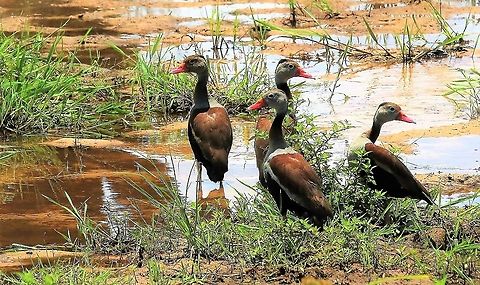
Appearance
The black-bellied whistling duck is a mid-sized waterfowl species. Length ranges from 47 to 56 cm, body mass from 652 to 1,020 g and wingspan ranges from 76 to 94 cm....hieroglyph snipped... It has a long pink bill, long head and longish legs, pale gray head and mostly gray-brown plumage. The belly and tail are black, and the body plumage, back of the neck and cap are a rich chestnut brown. The face and upper neck are gray, and they sport a thin but distinct white eye-ring. The extensive white in the wings is obvious in flight, less so on the ground; it is formed by the secondary remiges while the primaries are black; the wing-coverts are brown. Males and females look alike; juveniles are similar but have a gray bill and less contrasting belly.The wing bar is unique among whistling ducks. When on the ground, it may be hard to discern the light flanks present in many of these waterfowl. The fulvous whistling duck is the only sympatric whistling duck that shows such a whitish flank stripe, and it differs from the black-bellied by having dark wings and a lighter belly rather than the other way around. Juvenile "D. autumnalis" are quite similar to young of the white-faced whistling duck, which have a darker bill and no white wing patch; even when sitting they never seem to show white along the sides, as their thin white vertical barring on the black flanks is very indistinct.
As the name implies, these are noisy birds with a clear whistling "waa-chooo" call.
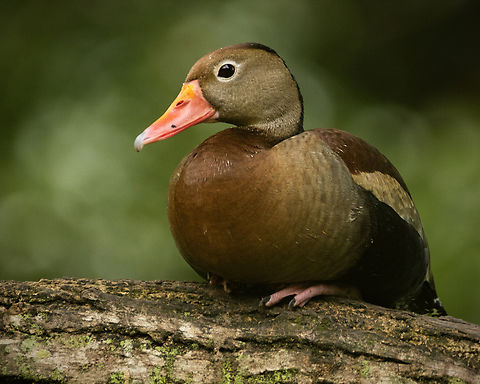
Distribution
This section possibly contains. Please by verifying the claims made and adding. Statements consisting only of original research should be removed.The black-bellied whistling duck is mainly non-migratory, although they are listed on the List of Birds protected by the Migratory Bird Treaty Act. At the heart of their range, there is a tendency to travel in flocks over the winter months, though this behavior is not a true long-range migration but rather local dispersal.
In the 21st century, small numbers have been observed nesting in the Midwestern U.S., including Ohio, Missouri, Illinois, Indiana, and Wisconsin; the species has also strayed to the eastern U.S. and Canada.
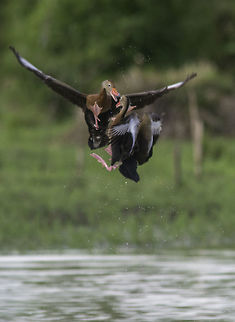
Status
The black-bellied whistling duck is listed as a species of least concern by the International Union for Conservation of Nature; its global population is estimated at 1,100,000–2,000,000 birds and increasing.
Behavior
The black-bellied whistling duck is a common species that is "quite tame, even in the wild". It is highly gregarious, or social, forming large flocks when not breeding, and is largely resident apart from local movements. It usually nests in hollow trees. The habitat is quite shallow freshwater ponds, lakes, and marshes, cultivated land or reservoirs with plentiful vegetation, where this duck feeds mainly at night on seeds and other plant food.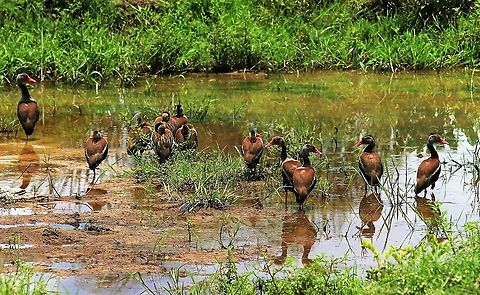
Habitat
This section possibly contains. Please by verifying the claims made and adding. Statements consisting only of original research should be removed.The black-bellied whistling duck is mainly non-migratory, although they are listed on the List of Birds protected by the Migratory Bird Treaty Act. At the heart of their range, there is a tendency to travel in flocks over the winter months, though this behavior is not a true long-range migration but rather local dispersal.
In the 21st century, small numbers have been observed nesting in the Midwestern U.S., including Ohio, Missouri, Illinois, Indiana, and Wisconsin; the species has also strayed to the eastern U.S. and Canada.The black-bellied whistling duck is a common species that is "quite tame, even in the wild". It is highly gregarious, or social, forming large flocks when not breeding, and is largely resident apart from local movements. It usually nests in hollow trees. The habitat is quite shallow freshwater ponds, lakes, and marshes, cultivated land or reservoirs with plentiful vegetation, where this duck feeds mainly at night on seeds and other plant food.
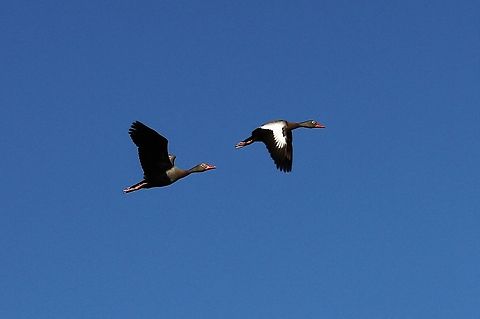
Reproduction
The black-bellied whistling duck is quite unique among ducks in their strong monogamous pair-bond. Its pairs often stay together for many years, a trait more often associated with geese and swans. Both parents share all tasks associated with the raising of young, from incubation to the rearing of ducklings. The ducks, primarily cavity nesters, prefer the confines of a hollow tree, but will nest on the ground when necessary. They also make use of chimneys, abandoned buildings, or nest boxes, the latter having been increasingly provided to them over recent decades, especially in southeast Texas and Mexico. Ducklings leap from nest cavities within two days of hatching, can feed themselves immediately, and stay with the parents for up to eight weeks.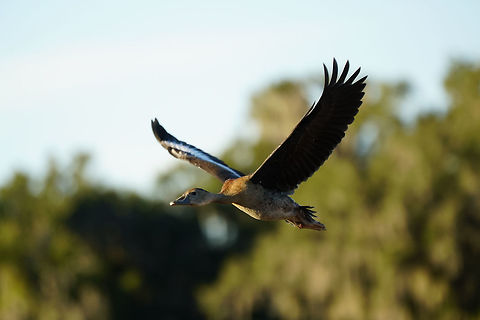
Food
Feeding often occurs nocturnally, but they can be encountered eating at any hour of the day. Black-bellied whistling ducks ingest a wide variety of plant material, but also consume arthropods, aquatic invertebrates and tadpoles when available. They often feed on submerged vegetation by wading through shallow water. As its Latin name implies, it is commonly seen gleaning recently harvested fields for leftover seeds and invertebrates brought up by the harvesters disturbing the soil.References:
Some text fragments are auto parsed from Wikipedia.